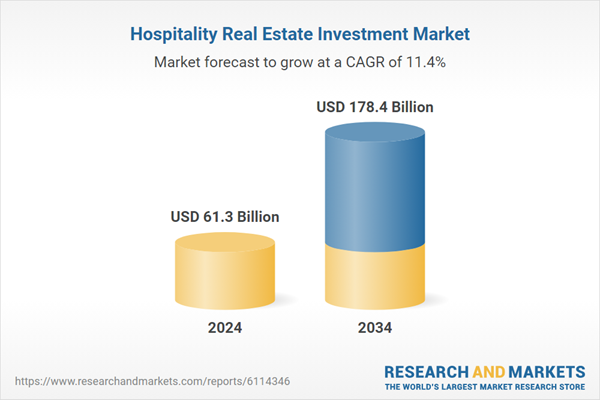Another factor fueling the market is the rapid pace of urban development, which continues to enhance regional connectivity and unlock new areas for hospitality expansion. Improved accessibility to travel destinations is making them more viable for hospitality development, thereby generating heightened interest among institutional and private investors. At the same time, shifting traveler behavior and lifestyle preferences are also reshaping the hospitality landscape. Investors are keen to back properties that go beyond traditional lodging and offer lifestyle-centric amenities, technology-driven guest experiences, and hybrid spaces suited for both leisure and work-related stays.
Hospitality spaces are no longer viewed merely as overnight accommodations but as integrated lifestyle experiences. This transition is especially apparent in traditional hotel formats, which held the largest market share of 53% in 2024 and are forecasted to grow at a CAGR of approximately 12% during the forecast period. Hotels are embracing a new identity by blending retail, wellness, and experiential offerings to appeal to modern travelers. With many properties now featuring pop-up retail spaces, branded showrooms, and collaborative events, the traditional hotel has evolved into a multi-functional venue that goes well beyond lodging. These features increase per-guest revenue and appeal to a broader range of travelers, making them a lucrative investment segment.
Extended stay and serviced apartments are also gaining traction due to growing demand from remote workers and business travelers. These properties offer the flexibility of long-term stays coupled with hotel-like services and comforts. With a CAGR of over 11% expected between 2025 and 2034, this segment is becoming increasingly attractive for investors seeking consistent returns with lower operational costs. The popularity of these properties lies in their ability to cater to evolving workplace dynamics and extended business assignments, which are reshaping the future of business travel accommodations.
The market is also segmented by investment structure, with real estate investment trusts (REITs) emerging as the leading choice for investors. In 2024, REITs accounted for a 45% share of the global hospitality real estate investment market and are anticipated to grow at a CAGR of around 12% from 2025 to 2034. REITs offer diversified exposure to hospitality assets without the complexities of direct property ownership. Their flexibility in reallocating capital, adjusting property portfolios, and responding swiftly to market changes makes them a preferred vehicle for both institutional and retail investors. Their scalability enables them to seize emerging opportunities in new locations or reposition assets to better align with shifting consumer preferences.
On the application front, the leisure and tourism segment leads the market, driven by travelers’ growing interest in experience-based, technology-integrated, and wellness-focused stays. As global travel resumes at scale, the demand for unique hospitality experiences continues to rise, spurring investments in resorts, boutique hotels, and destination-centric properties. Guests are increasingly valuing immersive travel that combines relaxation, local culture, and modern conveniences. As a result, properties that integrate smart room controls, eco-conscious design, and wellness programming are garnering heightened interest from investors.
Geographically, the United States dominates the North American hospitality real estate investment market, accounting for approximately 86% of the region’s revenue, which stood at USD 23.7 billion in 2024. The country's market leadership stems from its robust economic environment, mature hospitality infrastructure, and enduring demand from both domestic and international visitors. Transparent regulatory frameworks and a history of stable returns make the US a magnet for global capital. Additionally, the integration of technology in hotel operations - from mobile check-ins to energy management systems - further enhances investor confidence and guest satisfaction, positioning the country as a leader in next-generation hospitality investment.
Key industry players shaping this evolving market landscape include Apple Hospitality, Hilton, Choice Hotels, Host Hotels & Resorts, Marriott, Park Hotels & Resorts, InterContinental, RLJ Lodging, Pebblebrook Hotel, and Wyndham Hotel. These companies are actively expanding and diversifying their property portfolios to align with changing traveler behaviors and evolving investor priorities.
Comprehensive Market Analysis and Forecast
- Industry trends, key growth drivers, challenges, future opportunities, and regulatory landscape
- Competitive landscape with Porter’s Five Forces and PESTEL analysis
- Market size, segmentation, and regional forecasts
- In-depth company profiles, business strategies, financial insights, and SWOT analysis
This product will be delivered within 2-4 business days.
Table of Contents
Companies Mentioned
- Apple Hospitality
- Best Western
- Choice Hotels
- DiamondRock Hospitality
- G6 Hospitality
- Hilton
- Host Hotels & Resorts
- InterContinental Hotels
- Lowe Enterprises
- Marriott International
- Park Hotels & Resorts
- Pebblebrook Hotel
- PPHE Hotel
- Radisson
- RLJ Lodging
- Ryman Hospitality
- Sonesta RL
- Sunstone Hotel
- Georgetown
- Wyndham Hotel
Table Information
| Report Attribute | Details |
|---|---|
| No. of Pages | 170 |
| Published | July 2025 |
| Forecast Period | 2024 - 2034 |
| Estimated Market Value ( USD | $ 61.3 Billion |
| Forecasted Market Value ( USD | $ 178.4 Billion |
| Compound Annual Growth Rate | 11.4% |
| Regions Covered | Global |
| No. of Companies Mentioned | 20 |









